

Untitled. Birth rate. Oxfam Intermón. Oxfam Intermón denuncia que la recuperación beneficia cuatro veces más a los ricos: "El 13% de los trabajadores son pobres" How We Can Make the World a Better Place by 2030. No Point Going Halfway. Population pyramids: Powerful predictors of the future - Kim Preshoff. World Population Video.
Videographic: Migration. The city that won't stop growing. Chimamanda Ngozi Adichie: We should all be feminists. Geography: Population Maps. The Situation for Women and Girls Around the World? Stark. Subscribe to PassBlue Subscribe to our mailing list and get interesting stuff and updates to your email inbox.

Thank you for subscribing. Something went wrong. Women make up nearly two-thirds of Rwanda’s parliament, one of the highest rates globally. A legislator, above, attending an international parliamentary conference at the UN in August 2015. As the United Nations prepares to formally accept the new Sustainable Development Goals at midday at a summit meeting on Friday, here is a close look at one of the main resources that helped inform the long debate on creating the goals — the UN Development Program’s Human Development Report for 2014.
The SDGs — 17 objectives for 2015 to 2030 that all UN member states agreed on to replace the Millennium Development Goals — will be adopted at the UN meeting, taking place Sept. 25 to 27 in New York, with Pope Francis presiding as the pre-eminent speaker on Friday morning at 10 am. Gender Equality Index. Gender Inequality Index(GII) Human development Index. HDI 2016. Human Development Index - HDI. Video Definition Share Video A developed economy refers to a country with a relatively high level of economic growth and security.

Common criteria for evaluating a country's degree of development are per capita income or gross domestic product (GDP), level of industrialization, general standard of living, and the amount of widespread infrastructure. Noneconomic factors, such as the Human Development Index (HDI), which quantifies a country's levels of education, literacy and health into a single figure, can also be included in evaluating an economy or country's degree of development. BREAKING DOWN 'Developed Economy' The most well-known current examples of developed countries include the United States, Canada and most of western Europe, including the United Kingdom and France.
Developed Economy Criteria The most common metric used to determine if an economy is developed or nondeveloped is per capita GDP, though no set minimum exists. Human Development Index (HDI) The HDI was created to emphasize that people and their capabilities should be the ultimate criteria for assessing the development of a country, not economic growth alone.
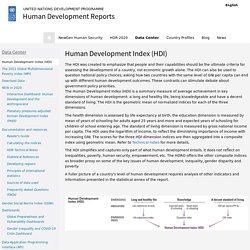
The HDI can also be used to question national policy choices, asking how two countries with the same level of GNI per capita can end up with different human development outcomes. These contrasts can stimulate debate about government policy priorities. Net migration rate by country - Thematic Map - World. Definition: This entry includes the figure for the difference between the number of persons entering and leaving a country during the year per 1,000 persons (based on midyear population).
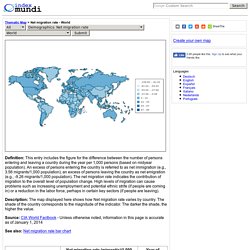
An excess of persons entering the country is referred to as net immigration (e.g., 3.56 migrants/1,000 population); an excess of persons leaving the country as net emigration (e.g., -9.26 migrants/1,000 population). The net migration rate indicates the contribution of migration to the overall level of population change. High levels of migration can cause problems such as increasing unemployment and potential ethnic strife (if people are coming in) or a reduction in the labor force, perhaps in certain key sectors (if people are leaving). Animated video- Human Development Report 2016. Human Development Reports. Human Development Index - Wikipedia. Composite statistic of life expectancy, education, and income indices World map representing Human Development Index categories (based on 2018 data, published in 2019).
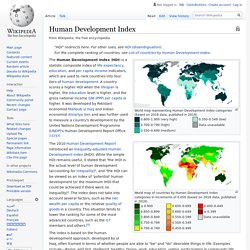
World map of countries by Human Development Index categories in increments of 0.050 (based on 2018 data, published in 2019). The index is based on the human development approach, developed by ul Haq, often framed in terms of whether people are able to "be" and "do" desirable things in life. Examples include—Being: well fed, sheltered, healthy; Doing: work, education, voting, participating in community life.
The freedom of choice is central—someone choosing to be hungry (as during a religious fast) is quite different from someone who is hungry because they cannot afford to buy food, or because the country is in a famine.[5] Origins[edit] Population Pyramids of the World from 1950 to 2100 - PopulationPyramid.net. Gapminder: Unveiling the beauty of statistics for a fact based world view. Making Population Real: New Lesson Plans and Classroom Activities. (April 2007) This manual provides a set of training materials selected from PRB's award-winning lesson plans "Making Population Real.
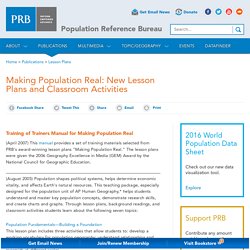
" The lesson plans were given the 2006 Geography Excellence in Media (GEM) Award by the National Council for Geographic Education. (August 2005) Population shapes political systems, helps determine economic vitality, and affects Earth's natural resources. This teaching package, especially designed for the population unit of AP Human Geography,* helps students understand and master key population concepts, demonstrate research skills, and create charts and graphs. Through lesson plans, background readings, and classroom activities students learn about the following seven topics:
Reading comprehension, English comprehension. The Population Bomb World population growth -- and how to slow it -- continues to be a subject of great controversy.
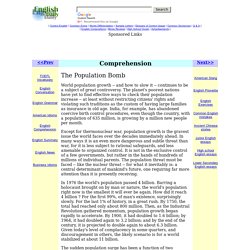
The planet's poorest nations have yet to find effective ways to check their population increase -- at least without restricting citizens' rights and violating such traditions as the custom of having large families as insurance in old age. India, for example, has abandoned coercive birth control procedures, even though the country, with a population of 635 million, is growing by a million new people per month. Except for thermonuclear war, population growth is the gravest issue the world faces over the decades immediately ahead. In many ways it is an even more dangerous and subtle threat than war, for it is less subject to rational safeguards, and less amenable to organized control.
Teachers' Resources - World Population. The following six lessons enable students to use different features of the site to explore trends in population, the environment, and human well-being over the past 2,000 years, as well as projections of future growth.

The lessons are designed for high school science and social studies classrooms and address current national and state standards, as well as content for several Advanced Placement (AP) courses. Links to standards and AP course outlines are available in a searchable database. In addition to meeting standards, students will be challenged to utilize 21st century skills and concepts. Through interpreting maps, analyzing real-world data sets, and engaging with technologies such as GIS, the lessons will further your students’ understanding of key global issues and empower them to be part of a sustainable future. The lessons can be used sequentially as a unit, or individually, to fit your teaching needs. GCSE Bitesize: Case study: China. Cookies are Not Accepted - New York Times.
Population pyramids: Powerful predictors of the future - Kim Preshoff. Hans Rosling: Global population growth, box by box. Learningfromgeography - Population. Skip to main content Create interactive lessons using any digital content including wikis with our free sister product TES Teach.
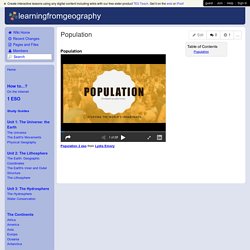
Get it on the web or iPad! Guest Join | Help | Sign In learningfromgeography Home guest| Join | Help | Sign In Turn off "Getting Started"